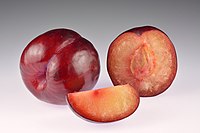
Photo from wikipedia
The physiochemical parameters and antioxidant properties of plum cultivars, grown in subtropical regions of China are little known. However, in this comparative study, these properties of 6 landraces and 7… Click to show full abstract
The physiochemical parameters and antioxidant properties of plum cultivars, grown in subtropical regions of China are little known. However, in this comparative study, these properties of 6 landraces and 7 introduced cultivars showed evaluated. The major nonvolatile constituents were a significant difference among cultivars. Color parameter values were strongly influenced by cyanidin 3-Oglucoside and cyanidin 3-O-rutinoside. Remarkably high antioxidant activity, high total phenolic, and ascorbic acid contents were found in black or purple flesh genotypes. Catechinic acid, the most important phenolic acid in Japanese plum, together with vanillic acid, caffeic acid and syringic acid, accounted for > 96% of the total phenolic content. The total phenolics and ascorbic acid concentration revealed significant contributions to antioxidant capacity detected by α, α-diphenyl-β-picrylhydrazyl (DPPH), (r = 0.78**, 0.73**) and ferric reducing antioxidant power (FRAP) (r = 0.74**, 0.57*). Moreover, there was a clear correlation between the total phenolic compounds and the ascorbic acid content (r = 0.76**). Comparison of physicochemical characteristics and antioxidant profiles revealed that both introduced cultivars and landraces had good adaptability in the subtropical region.
Journal Title: Applied Ecology and Environmental Research
Year Published: 2020
Link to full text (if available)
Share on Social Media: Sign Up to like & get
recommendations!